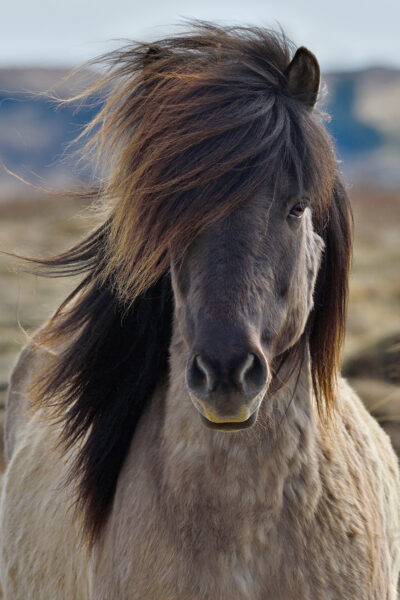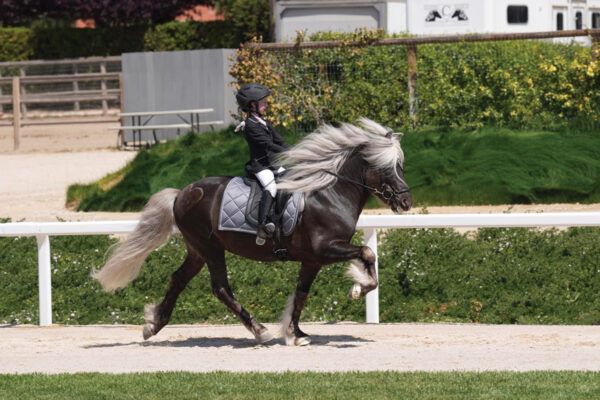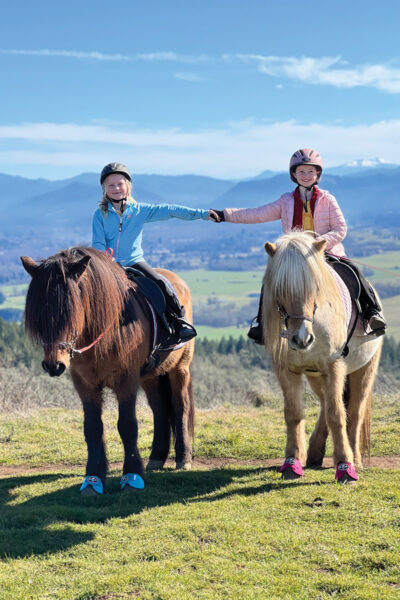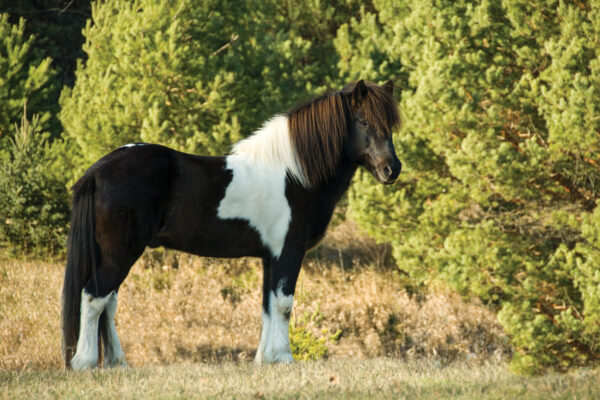The island country of Iceland is nestled where the waters of the Atlantic and Arctic Oceans meet, with Greenland to the west and Norway to the east. It’s a country of approximately 370,000 people, and is home to one of the world’s most beloved gaited breeds: the Icelandic horse.

Imagine a breathtaking icy landscape, inhabited by hardy, rugged horses that are well-suited to life in a cold northern climate. The horses have plenty of substance, abundant manes and tails, and five distinct gaits: the walk, trot, canter, tölt, and flying pace. They’re endearingly beautiful and enduringly long-lived. There’s a lot to love about Icelandics!
Are Icelandic Horses Actually Ponies?

Sharp-eyed readers may point to the Icelandic’s height of 12 to 14 hands and say, “Hey, that’s not a horse—that’s a pony!” And while it’s true that most horse/pony divisions hinge on the critical 14.2 hands as a reference point, there is no word for “pony” in the Icelandic language.
This might be because there was historically only one type of equine on the island, and thus no need for multiple words to differentiate between them. But there’s more to it than that—the Icelandic horse has a shape and characteristics that are more reminiscent of a horse’s build than a pony’s, similar to the way Miniature Horses retain horse proportions despite their tiny size.
No Equine Imports
So why is there only one type of equine in Iceland? For almost 1,000 years (that’s about four times longer than the U.S. has been a country!), the people of Iceland have carefully bred and maintained the horses, which are probably the descendants of Viking horses brought by ships.
During that time, Icelandic horse breeders have been very careful not to allow outside horses onto the island, so the Icelandic horse gene pool has remained pure for all these centuries. Even today, this strict policy remains in effect, and no horses are allowed to be imported onto the island, ensuring that the original genetic lines of the Icelandic horse remain undiluted by other breeds. And once an Icelandic horse is exported off the island, Icelandic law prevents it from ever re-entering. Pretty amazing!
As mentioned, the Icelandic horse has two additional special gaits beyond the typical walk/trot/canter. The Icelandic’s famous tölt is a four-beat gait with a lack of suspension, allowing the rider to enjoy a quick speed in a very smooth ride. The flugskeið gait is also called the flying pace: a lateral gait where each pair of legs on a horse’s side move together, like a Standardbred’s pace.
Icelandic Horse Youth Involvement
If you can’t wait to participate in Icelandic horse activities, the United States Icelandic Horse Congress (USIHC) offers a variety of fun youth programs. One of the newest is the USIHC PenPal Program, which connects youth participants who love Icelandics and wish to exchange letters for one year.

The USIHC offers National Ranking shows, educational opportunities, and plenty of ways for youth members to get involved. Membership comes with fun bonuses: access to all archived back issues of the USIHC’s quarterly magazine as well as access to the online studbook—great for students of bloodlines and pedigrees!
Regardless of where you live, USIHC members can also participate in the Sea 2 Shining Sea Ride. This is a free virtual ride where you can log hours spent in the saddle and compete as an individual or on a team.
Love to write? The Spaeri Youth Award is awarded annually to a youth member who exhibits determination and a deep commitment to the Icelandic breed, based on articles submitted for the quarterly magazine.
If you’re especially serious about Icelandics and expanding your skill and knowledge, you might be interested in the international FEIF Youth Cup or FEIF Youth Camp, which are held in Europe every two years. (FEIF, the International Federation of Icelandic Horse Associations, is the international governing body for the breed).
Did You Know?
◆ Icelandics range in size from 12 to 14 hands, but 13 to 14 hands is most common, and 12.2 to 13.2 hands is considered ideal.
◆ All colors, along with pinto patterns, are acceptable. According to the U.S. Icelandic Horse Congress, Icelandics can be found in more than 100 color variations, and the breed standard encourages preservation of a wide range of colors.
◆ There are approximately 280,000 Icelandic horses worldwide, with about 90,000 of those in Iceland. Just under 6,000 reside in the United States.

Whether you have your own Icelandic horse or simply love the breed, there are plenty of ways to get involved with Icelandics and join the fun!
This article about the Icelandic horse appeared in the November/December 2022 issue of Young Rider magazine. Click here to subscribe!


